
Hopeful Gains in Higher Education for Mexican Americans
By Humberto Gutierrez
Edited by Kristen House
The latest figures from the 2013 American Community Survey show progress in the wide gap between the total US professional population and Mexican Americans:
- 2012 college and/or graduate enrollment was 28.8% for the total population but only 18.2% for Mexican Americans.
- 2013 college and/or graduate enrollment was 28.3% for the total population, 18.1% for Mexican Americans, and 33.3% for foreign-born Mexican Americans.
College enrollment for the total population has decreased from the years 2012 to 2013 by 463,000 according the Census Bureau as stated in their Sept. 24, 2014 press release.
For Mexican Americans, there was also an enrollment decrease, but not as pronounced. Mexican American enrollment dropped by only .1% whereas for the total population, there was a .5% drop in college enrollment.

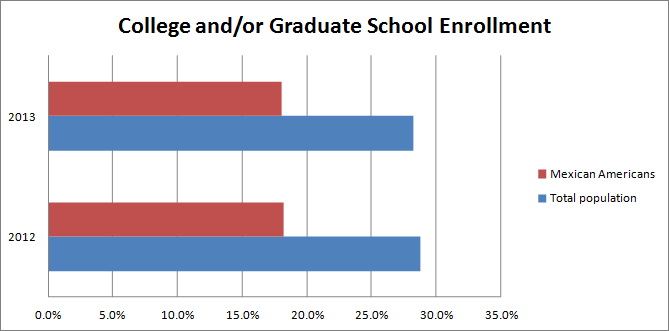
EDUCATIONAL ATTAINMENT
Educational attainment for the general population has risen by .3% from the years 2012 to 2013. For Mexican Americans, it has decreased by .1%
Earned bachelor’s degrees for the general population have risen by .2% and a bit more for Mexican Americans at .3%
Associate degrees and/or some college has shown little change across the board.
Unfortunately, only 2.8% of Mexican Americans and 1.5% of foreign-born Mexican Americans completed a graduate or professional degree in 2013. This is an extremely low percentage because the total population completion of a graduate or professional degree in 2013 was 11.2%. Why are Mexicans and native-born Mexicans not obtaining their graduate degrees? While only 7.3% of Mexican Americans have B.A. degrees, many are settling for associate degrees—21.8% of Mexican Americans and 12.1% of foreign-born Mexican Americans are ending their academic careers upon achieving these two-year degrees, according to the 2013 data.
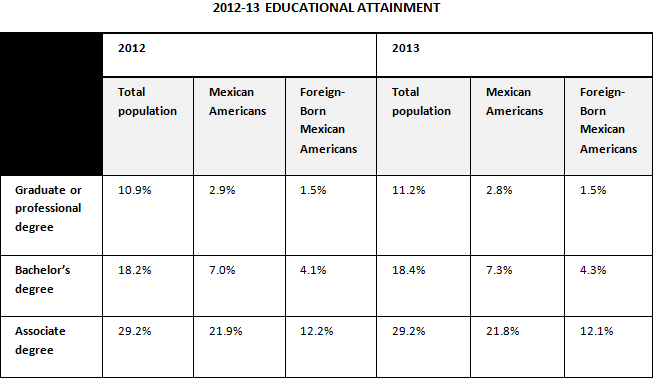

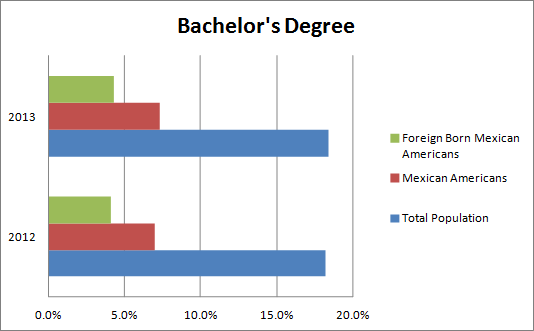
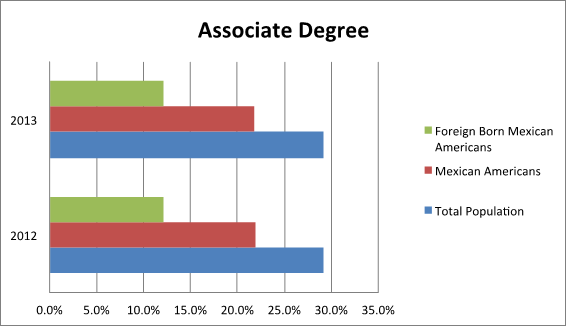
OCCUPATIONS
For the year 2013, the data for civilian employed population 16 years and over in management, business, science, and arts occupations is: 36.3% for the total population, 16.7% for Mexican Americans, and 9.2% for foreign-born Mexican Americans. Again, dismal figures.
Compared to the 2012 results, which were for the total population of 36.1% and for Mexican Americans 16.6%, there was a .2% increase for the total population and .1% for Mexican Americans. There was also a .2% increase for foreign-born Mexican Americans. Not much change, but some hope.
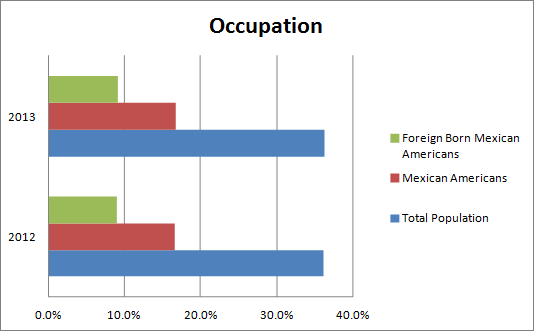
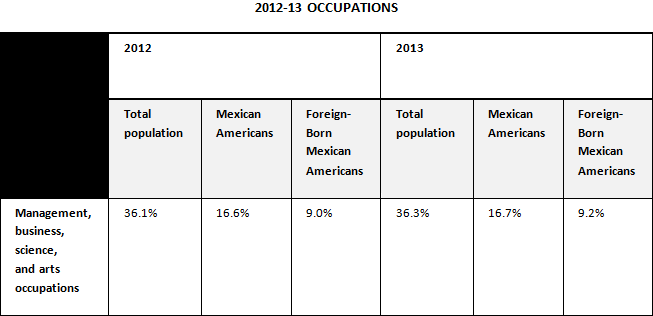
INDUSTRY
For professional, scientific, management and administration, and waste management services, 2013 employment for the total population was 11.1% and 10.2% for Mexican Americans, with foreign-born Mexican Americans at 11.5%. The 2012 results were for the total population 10.9% and 10.2% for Mexican Americans with the foreign-born Mexican Americans at 11.6%. No change for Mexican Americans and a .2% increase for the total population. However, a happy surprise: in 2013, foreign-born Mexican Americans topped all groups at 11.5% with a small decrease from 2012.
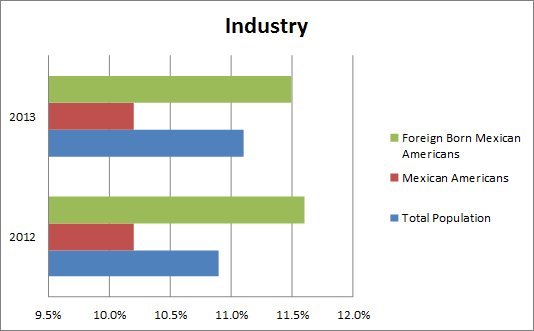
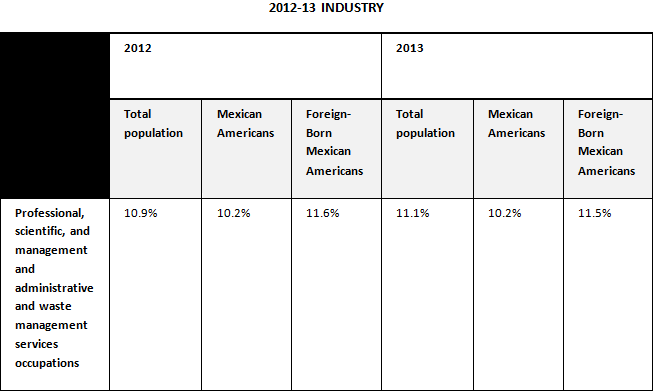
This represents a mixed picture for Mexican Americans and for foreign-born Mexican Americans in their quest for parity with the total population.
Solution for Retaining Minority Students in Higher Education
Scott Watson Swail’s 2003 report (1) on student retention programs in higher education states that a comprehensive student retention program should:
- rely on proven research
- suit the particular needs of the campus
- be institutionalized and become a regular part of campus service
- involve all campus departments and all campus personnel
- take into consideration the dynamics of the change process and provide extensive and appropriate retraining of staff
- be student centered
- operate in a cost-effective way, and not be tied to soft monies
- have the support of a comprehensive student monitoring system that will become the foundation of all institutional research on campus and support every department
- be sensitive to student needs and to diverse populations.
At least some of the above recommendations would go a long way to encourage many minority students to continue their higher education by obtaining a graduate or professional degree.
Berkley, Stanford, UCLA, and Caltech collaborate to boost minority Ph.D. students by recruiting underrepresented students in mathematical, physical and computer sciences, and in engineering.
UC Berkley put it best: “The four schools are creating a unique, cross-institutional community of underrepresented minority Ph.D. students, postdoctoral scholars, and faculty members in the targeted fields; developing faculty training to better recognize and help these students thrive and advance; and conducting research that includes annual surveys of Ph.D. students about what factors impact their attitudes, experiences and preparation for the future.”(2)
References
- Census Bureau, Selected Population Profile in the United States: 2012 and 2013
- United States S0201 and B 05006. Selected population Profile in the United States
- Population groups: Mexican and Mexico (foreign-born)
- Data set: American Community Survey 1-Year Estimates for years 2012 and 2013.
- Census Bureau, American Fact Finder, Selected population Profile in the Untied States.
————————————————–
(1) Watson Scott Swail, Retaining Minority Students in Higher Education: A Framework for Success, George Washington University, 2003
(2) Gretchen Kell, “Berkeley, Stanford, UCLA, Caltech unite to boost number of minority Ph.D. students, faculty,” UC Berkley News Center, February 13, 2014


